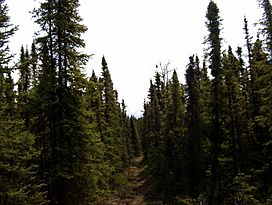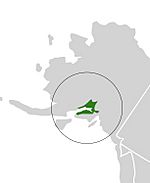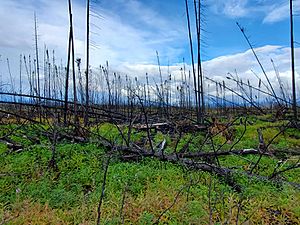Cook Inlet taiga facts for kids
Quick facts for kids Cook Inlet taiga |
|
|---|---|

Taiga forest in the Kenai National Wildlife Refuge
|
|

Map of the Cook Inlet taiga
|
|
| Ecology | |
| Realm | Nearctic |
| Biome | Boreal forests/taiga |
| Borders | Alaska-St. Elias Range tundra, Northern Pacific coastal forests, and Pacific Coastal Mountain icefields and tundra |
| Geography | |
| Area | 27,790 km2 (10,730 sq mi) |
| Country | United States |
| State | Alaska |
| Conservation | |
| Conservation status | Relatively stable/intact |
| Protected | 8,439 km² (30%) |
The Cook Inlet taiga is a special kind of forest in Alaska. It's a mix of taiga and boreal forests. An ecoregion is a large area of land or water that has its own unique plants, animals, and environment.
Where is the Cook Inlet Taiga?
This amazing forest is found around the upper Cook Inlet. This is on the south-central coast of Alaska. Mountains surround and protect this area.
The land here is quite gentle. The climate is also milder than many other parts of Alaska. It gets about 380 to 680 millimeters of rain each year.
Plants of the Taiga
The Cook Inlet taiga has many different kinds of plants. You'll find a mix of cone-bearing trees (conifers), other trees, shrubs, and small plants.
Some of the main trees here are:
- Black spruce (Picea mariana)
- White spruce (Picea glauca)
- Large Sitka spruce (Picea sitchensis)
- Quaking aspen (Populus tremuloides)
- Balsam poplar (Populus balsamifera)
- Black cottonwood (Populus trichocarpa)
- Paper birch (Betula papyrifera)
Sometimes, tiny insects called spruce bark beetles cause damage to the spruce trees. But the forest is strong! New trees grow back, keeping the forest healthy.
Amazing Animals
This area is full of exciting wildlife. You might spot grey wolves, different types of bears, and even Canada lynx.
The Kenai River flows through this region. It's famous for its fish! Five different kinds of Pacific salmon live here. This includes the biggest chinook salmon in the world.
Many birds also call this place home. You can see lots of bald eagles. In winter, many snow geese from Wrangell Island gather at the mouth of the Kenai River. They rest here before flying north in the spring.
Keeping the Taiga Safe
The areas around the Kenai River, Anchorage, Palmer, and Wasilla are the most populated parts of Alaska. These places are important for industries like logging and oil. Some land is also cleared for farming in Palmer and Point MacKenzie.
Even with these activities, most of the natural habitats are still very well preserved. However, the wildlife on the Kenai Peninsula has become separated from animals in other parts of Alaska. This includes the Matanuska-Susitna Valley and the west side of Cook Inlet.
Many special places help protect this beautiful taiga. These include:
These protected areas help keep the Cook Inlet taiga a safe home for its plants and animals.



